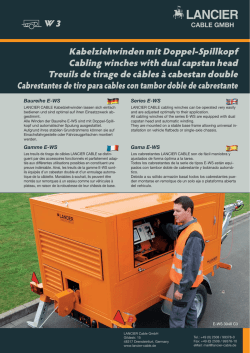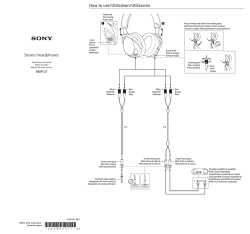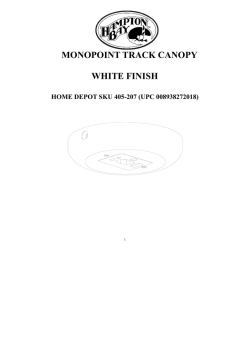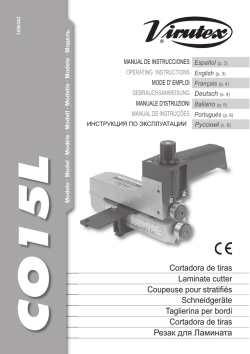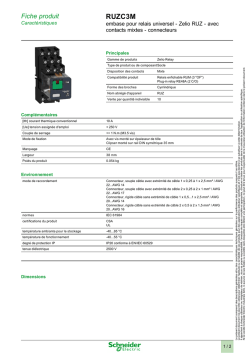
Soil Heating Cable
FR INSTRUCTIONS / GUIDE DE L’UTILISATEUR Félicitations ! Vous avez acquis le Câble de Chauffage pour Sols Jump Start. Si vous l’utilisez correctement en suivant cette notice, vous obtiendrez d’excellents résultants pendant très longtemps. PRECAUTIONS DE SECURITE AVERTISSEMENT : SI LES INSTRUCTIONS NE SONT PAS SUIVIES CORRECTEMENT, IL POURRAIT SE PRODUIRE UNE DÉCHARGE ÉLECTRIQUE. •Suivez toujours cette notice pour installer et utiliser le câble chauffant Jump Start. Une utilisation NE PAS: incorrecte pourrait provoquer des incendies, décharges électriques et/ou Fig. A dégâts sur les graines et plantes. •Le câble chauffant doit être correctement enterré de façon à ne pas être à la vue de la partie colorée pendant son utilisation. Si le câble était exposé, il pourrait provoquer un réchauffement, une panne ou autres Fig. B dangers. •Ne pas utiliser un câble chauffant unique pour différentes surfaces de culture. •Ne pas brancher le câble s’il est enroulé ni pendant son installation. Fig. C •Ne pas croiser le câble chauffant (Fig. A). •Les différentes parties du câble ne doivent pas se toucher (Fig. B). •Ne pas couper ni ouvrir le câble (Fig. C). •Ne pas utiliser le câble chauffant s’il y a des objets qui pourraient l’endommager ou s’il doit rester sous l’eau pendant longtemps. •Pour éviter les décharges électriques, débranchez toujours le câble pendant que vous travaillez dans le jardin ou la zone de culture. NOTICE D’INSTALLATION Avant l’installation, s’assurer que la zone de culture ne contient pas d’objets coupants ni de zones inondées. Examiner le câble au cas où il aurait des coupures ou autres défauts. Si une des parties du câble chauffant est endommagée, contacter le fournisseur. Ne pas utiliser le câble s’il est endommagé. 1. Placer une couche de terre d’environ 5 cm sur la zone de culture choisie. 2. Placer le câble sur la terre (voir la Fig. D), avec les sections séparées d’environ huit centimètres pour obtenir une distribution uniforme de la chaleur. Fig. D hydrofarm.com FR Instructions and Warranty INSTRUCTIONS / GUIDE DE L’UTILISATEUR 3. Placer une maille en métal ou plastique sur le câble chauffant (voir la Fig. E). La maille aidera à fixer le câble Fig. E et le protègera des dégâts que pourraient provoquer les outils. Utiliser une bride ou un cordeau pour unir, soigneusement, le câble à la maille. Utiliser des fermetures seulement sur les parties droites du câble chauffant (pas dans les courbes). Ne pas trop serrer le câble à la maille. 4. Brancher le câble chauffant et vérifier qu’il n’a pas été endommagé pendant l’installation. Après l’avoir examiné, brancher le câble. 5. Ajouter de la terre sur le câble. Vous aurez besoin d’environ huit centimètres de terre. 6. Brancher le câble chauffant et le laisser atteindre sa température maximale. Mesurer la température de la terre à différents points pour vérifier son uniformité. La température pourrait varier légèrement en fonction des conditions environnementales et de l’écartement du câble, cependant elle devrait se trouver entre 22 et 29ºC. Ajouter ou retirer de la terre pour obtenir la température voulue - une quantité inférieure de terre augmente la température et une quantité supérieure la diminue. Il se pourrait que vous deviez replacer le câble pour obtenir une répartition correcte de la chaleur (voir Étape 2). Soil Heating Cable GUIDE DE L’UTILISATEUR 1. Brancher, si possible, le câble chauffant à un interrupteur avec mise à la terre (GFCI). Ceci fournira une protection supplémentaire en cas de décharges électriques. 2. Le câble chauffant a été conçu pour fonctionner 24h sur 24 ou le temps nécessaire. Si vous n’avez pas besoin du câble pour chauffer le sol, débranchez-le ou éteignez-le. 3. Vérifier fréquemment le niveau d’humidité du sol pour améliorer la germination et la vie des plantes. 4. Utilisez des outils en plastique pour semer, cultiver ou récolter votre jardin ou zone de culture et prenez soin de ne pas altérer la position ou le fonctionnement du câble chauffant durant le processus. GARANTIE The Jump Start Soil Heating Cable gently warms your growing medium for faster germination and better growth. Use indoors or out, in containers, cold frames, or right in the ground for plants that are sensitive to being transplanted. Flexible, insulated cable can be arranged to fit any growing area. The integrated thermostat turns the cable off when soil reaches your target temperature, and on again when things cool down. Hydrofarm garantit le produit contre tout défaut de fabrication durant un an à partir de la date d’acquisition. En cas de non respect de ces instructions ou d’utilisation incorrecte du produit, la garantie ne couvrira pas les éventuels dégâts. Hydrofarm pourra réparer ou remplacer le produit à condition qu’il soit ramené au lieu original de l’achat. Pour faire fonctionner la garantie, ramener le produit avec le ticket d’achat et l’emballage original au lieu d’achat. La date d’acquisition sera la date indiquée sur le ticket original. hydrofarm.com hydrofarm.com ENG INSTRUCTIONS / USER GUIDE Congratulations on your purchase of a Jump Start Soil Heating Cable! With proper use and care according to these instructions, you should get excellent results for years to come. SAFETY PRECAUTIONS WARNING: FAILURE TO FOLLOW OUR GUIDELINES COULD RESULT IN ELECTRICAL SHOCK. •Always install and use the Jump Start Soil DO NOT: Heating Cable according to instructions. Incorrect use can cause danger of fire, Fig. A electric shock, and/or damage to seeds and plants. •The heating cable must be properly buried in soil or soil-based mixtures so that no portion of the colored heating section is visible while in use. Exposing heating cables Fig. B could result in overheating, failure, and possibly hazardous conditions. •Do not attempt to use a single heating cable for multiple trays or garden beds. •Do not plug in heating cable in while coiled Fig. C or while installing. •Do not cross heating cable (Fig. A). •Do not allow sections of heating cable to touch each other (Fig. B). •Do not dig into or cut heating cable (Fig. C). •Do not use the heating cable where any objects could damage the cord, or where the heating cable could become submersed in water for long periods. •To avoid electrical shock, always disconnect your heating cable while working around your garden bed or tray. INSTALLATION INSTRUCTIONS Before installation, make sure your growing area is free of sharp objects and/or puddling. Inspect the heating cable for cracks or defects. If any part of your heating cable is damaged, notify your retailer. Do not use a damaged heating cable. 1. Apply a 2" thick layer of sand in the designated growing area. 2. Lay out the heating cable on top of the sand, with sections spaced no more than three inches apart to maintain consistent heat spread (see Fig. D). ENG INSTRUCTIONS / USER GUIDE 3. Place metal or plastic hardware cloth (sold separately; available at hardware stores) on top of heating Fig. E cable (see Fig. E). The hardware cloth will help hold the heating cable in place, and help protect it from damage from tools. Use a cable tie, twine, or string to gently attach the cable to the hardware cloth. Use fasteners only along straight portions of the heating cable (not on corners). Do not fasten the heating cable too tightly to the hardware cloth. 4. Plug in the heating cable and inspect to make sure it was not damaged during installation. After inspection is complete, unplug the heating cable. 5. Begin adding top soil over the heating cable. Roughly three inches of soil will be needed. 6. Plug in the heating cable and allow it to reach its maximum operating temperature. Measure soil temperature at multiple points to test for consistency. Temperature may vary slightly depending on environmental conditions and spacing of cable, but should be between 72 °F and 85 °F. Add or remove top soil as needed to achieve desired temperature – less soil to raise temperature, more soil to lower temperature. You may also need to reposition the heating cable to maintain proper heat displacement (see Step 2, above). USER GUIDELINES 1. If available, plug your heating cable into a ground fault circuit interrupter (GFCI) device. This will provide additional protection from electrical shock. 3. The heating cable is designed to operate 24 hours a day or as needed. When cable is not required to heat the soil, always unplug or switch off the cable. 4. Check your soil moisture level often. This will enhance results for germination and/or plant life. 5. Use plastic tools while seeding, cultivating, or harvesting in your garden bed or tray. Be careful not to disturb the heating cable during this process. WARRANTY Hydrofarm warrants this product to be free from defects in materials and workmanship for a term of one year beginning on the date of purchase. Misuse, abuse, or failure to follow instructions is not covered under this warranty. Hydrofarm will, at our discretion, repair or replace the product covered under this warranty if it is returned to the original place of purchase. To request warranty service, please return the product, with original sales receipt and packaging, to your place of purchase. The purchase date is based on your original sales receipt. Fig. D hydrofarm.com hydrofarm.com ESP INSTRUCCIONES / GUÍA DE USUARIO ¡Enhorabuena! Ha adquirido el Cable de Calefacción para Suelos Jump Start. Si lo utiliza adecuadamente siguiendo estas instrucciones, obtendrá unos resultados excelentes durante mucho tiempo. PRECAUCIONES DE SEGURIDAD ESP 3. ADVERTENCIA: SI NO SE SIGUEN LAS INSTRUCCIONES CORRECTAMENTE PODRÍA PRODUCIRSE UNA DESCARGA ELÉCTRICA. •Siga siempre estas instrucciones a la hora NO: de instalar y utilizar el cable calefactor Jump Start. Un uso incorrecto podría provocar Fig. A incendios, descargas eléctricas y/o daños a las semillas y plantas. •El cable calefactor debe estar correctamente enterrado en el suelo de forma que, mientras está en uso, no quede a la vista la parte coloreada. En caso de que Fig. B el cable quede expuesto podría provocar un sobrecalentamiento, avería u otras condiciones peligrosas. •No utilice un único cable calefactor para distintas superficies de cultivo. Fig. C •No enchufe el cable cuando está enrollado o mientras se está instalando. •No cruce el cable calefactor (Fig. A). •Las distintas partes del cable no deben tocarse (Fig. B). •No corte ni abra el cable (Fig. C). •No utilice el cable calefactor si existen objetos que podrían dañarlo o si pudiera permanecer sumergido en agua durante largos periodos de tiempo. •Para evitar descargas eléctricas, siempre desconecte el cable mientras trabaja en el jardín o la zona de cultivo. INSTRUCCIONES DE INSTALACIÓN Antes de la instalación, compruebe que la zona de cultivo no tiene objetos afilados ni zonas encharcadas. Examine el cable por si tuviese grietas u otros defectos. En caso de que alguna de las partes del cable calefactor esté dañada, póngase en contacto con su proveedor. No utilice el cable si está dañado. Fig. D 1. Coloque una capa de tierra de unos 5 cm en la zona de cultivo designada. 2. Sitúe el cable sobre la tierra (véase la Fig. D), con las secciones separadas aproximadamente ocho hydrofarm.com 4. 5. 6. INSTRUCCIONES / GUÍA DE USUARIO centímetros para conseguir una distribución uniforme del calor. Coloque una malla Fig. E de metal o plástico sobre el cable calefactor (véase la Fig. E). La malla le ayudará a sujetar el cable y lo protegerá de cualquier daño que pudieran provocar otras herramientas. Utilice una brida o un cordel para unir, con cuidado, el cable a la malla. Utilice cierres solo en las partes rectas del cable calefactor (no en las curvas). No apriete demasiado el cable a la malla. Enchufe el cable calefactor y compruebe que no se ha dañado durante la instalación. Después de examinarlo, desenchufe el cable. Añada tierra sobre el cable. Necesitará aproximadamente unos ocho centímetros de tierra. Enchufe el cable calefactor y deje que alcance su temperatura máxima. Mida la temperatura de la tierra en diferentes puntos para comprobar su uniformidad. La temperatura podría variar ligeramente dependiendo de las condiciones ambientales y del espaciado del cable, pero debería encontrarse entre 22ºC y 29ºC. Añada o retire tierra para conseguir la temperatura deseada - menor cantidad de tierra aumenta la temperatura y mayor cantidad de tierra la disminuye. Podría tener que recolocar el cable para conseguir una distribución correcta del calor (véase Paso 2). GUÍA DEL USUARIO 1. Si es posible, enchufe el cable calefactor a un interruptor de circuito por falla a tierra (GFCI). Lo que le proporcionará una protección adicional ante descargas eléctricas. 3. El cable calefactor está diseñado para su funcionamiento durante 24 horas al día o el tiempo que sea necesario. En caso de que no se necesite el cable para calentar el suelo, siempre desenchufe o apáguelo. 4. Compruebe con frecuencia el nivel de humedad del suelo, de esta forma mejorará la germinación y la vida de sus plantas. 5. Utilice herramientas de plástico al sembrar, cultivar o cosechar en su jardín o zona de cultivo y tenga cuidado de no alterar la posición o funcionamiento del cable calefactor durante el proceso. GARANTÍA Hydrofarm garantiza que el producto no presentará defectos de fabricación durante un año desde la fecha de compra. En caso de no respetarse estas instrucciones o de un uso inadecuado del producto, la garantía no cubrirá los posibles daños. Hydrofarm, a su discreción, podrá reparar o sustituir el producto siempre que se devuelva al lugar original de compra. Para reclamar la garantía, devuelva el producto con el ticket de compra y el embalaje original al punto de compra. La fecha de adquisición será la indicada en el ticket original. hydrofarm.com
© Copyright 2025
